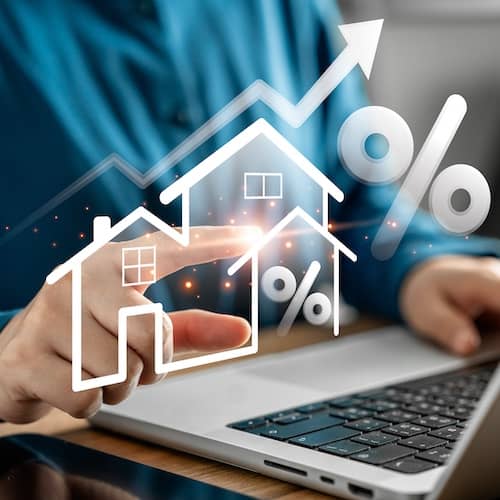Absorption rate: What is it and how to calculate it
Contributed by Tom McLean
Apr 24, 2025
•4-minute read
Timing is essential when you’re trying to get the best deal selling or buying a home. One tool you can use to evaluate the market is the absorption rate, which measures how quickly homes are selling. Knowing how it’s calculated and what it means can help you decide on the right time to buy or sell your home.
What is the absorption rate in real estate?
The absorption rate measures how fast homes are selling. It’s a simple mathematical formula that divides the number of homes sold by the number of available homes over a specific time. You can limit the factors used to calculate the absorption rate in a particular area based on location, price range, and property type.
An absorption rate of 20% or higher suggests a seller’s market with high demand for homes. A rate below 15% signals you’re looking at a buyer’s market instead of a seller’s market. A rate between 15% and 20% is a neutral market. Don’t be surprised to find numbers beyond this range. Absorption rates can climb above 60% or fall below 5%, depending on economic factors.
You can use the absorption rate to your advantage. A higher absorption rate means your home should sell your house quickly and may command a higher-than-normal price. If you’re a buyer, you may want to hold off or look for a less competitive market to get the most home for your money.
Buyers can expect more homes to choose from, lower prices, and less competition in an area with a low absorption rate. Sellers facing a low rate can expect it will take longer to sell and lower offers.How professionals use absorption rate
Real estate agents and brokers use absorption rates to track demand, which in turn affects home prices. Other professionals also use the absorption rate:
- Home appraisers use absorption rates to validate appraisals.
- Contractors and developers use absorption rates to gauge interest in new homes. It affects what they build and where.
- Real estate investors use absorption rates to determine the best places to buy or sell.
How to calculate absorption rate
You can calculate the absorption rate with a simple formula: Divide the number of homes sold in a time frame by the number of homes available.
By adjusting what homes you’re looking for, you can find a more accurate rate that applies to you. For example, you may want to include only the homes in a single ZIP code or within a specific price range.
An example absorption rate calculation
Say 10 homes have sold in a neighborhood where you’re looking to buy a home during the past month. If 45 homes in total were for sale in this neighborhood, you’d divide 10 by 45 to get an absorption rate of 22%. This suggests a slight seller’s market as it’s above the 20% threshold. If you were selling a home in this market, you’d be at a modest advantage with higher demand and home prices.
High vs. low absorption rates
Let’s consider two scenarios on how high and low absorption rates affect home prices.
Town A has sold 1,000 houses out of 4,000 in the past 12 months, resulting in a 25% absorption rate. A 25% absorption rate categorizes Town A as a seller’s market.
- Inventory is low compared to demand.
- Average prices will increase due to more competition for a limited number of homes.
- Sellers will sell their homes faster and at a higher price.
- Buyers can expect to pay more with higher competition, reduced options, and a greater chance of a bidding war.
Town B has sold 500 houses out of 4,000 total houses in the past 12 months, resulting in a 12.5% absorption rate. Considering this is lower than 15%, Town B is a buyer’s market.
- Average prices will decrease due to less competition for more homes.
- It will take more time for sellers to sell their homes, and they’ll likely lower their asking prices.
- With lower competition, buyers have more homes to choose from and can buy at a lower price.
How absorption rates affect housing prices
Knowing your market’s absorption rate better prepares you to make a wise decision regarding price. You should know if you’re in a seller’s market to properly negotiate a higher price from buyers.
Likewise, you should know if you’re in a buyer’s market to avoid overbidding when prices are falling. As a buyer, you have the advantage of lower market demand.
Lenders and appraisers also consider the absorption rate, which impacts the cost of homes. If you know what they know, you can anticipate price changes and make the right call.
The importance of months supply of inventory
Knowing the absorption rate provides information on another useful metric known as months supply of inventory. MSI measures how many months it would take to sell all the homes in a market at the current absorption rate.
The calculation is an inverse of the absorption rate formula: Divide the number of available properties by the average number of sales per month, and you get the MSI.
Here’s a quick example: If a town had 4,000 properties on the market and sold 1,000 on average per month, it would take 4 months to sell them all. This assumes no new homes are put up for sale.
MSI is another way to determine what kind of market you’re in.
- A low MSI is a seller’s market. As a buyer, you’ll want to act quickly to put down an offer on a home because of increased competition for a dwindling supply of homes.
- A high MSI is a buyer’s market. As a seller, you’ll want to strategize with professionals to attract buyers because the market has too many homes for sale.
Developers also track MSI. Areas with a lower supply of homes may bring in new construction to capitalize on the shortage.
The bottom line: Absorption rate measures how quickly houses are sold
The absorption rate in a market helps you understand how supply is meeting demand. When the absorption rate rises above 20%, you benefit as a seller by getting more money for your home. When the absorption rate falls below 15%, you benefit as a buyer by having more choices at a cheaper price.
As a participant in the housing market, you want as much information as possible to make wise decisions. Read this article to learn more about 2025 housing predictions and forecasts.
Michael Rosenthal
Michael Rosenthal brings over a decade's worth of experience writing for finance, tech, education, and entertainment. He earned his bachelor’s in writing and a certificate in public & professional writing from the University of Pittsburgh along with a master’s in television production from Boston University.
His previous work includes developing personal finance education for a Fortune 500 company and articles for various mortgage lenders. When he’s not writing for Rocket Mortgage, Michael spends his time fixing up his well-aged home in Los Angeles one leaky sprinkler at a ti
Related resources

9-minute read
A guide to real estate and housing market indicators
Housing market indicators shed light on home affordability, home inventory, and more. Leverage market data and make the most of your next real estate purchase.
Read more

6-minute read
What is a CMA in real estate? A complete guide
Learn what a comparative market analysis (CMA) is, what it does, and how it can help you determine a property’s value by comparing similar homes in you...
Read more

8-minute read
When is the best time of year to buy a house?
Wondering about the best time of year to buy a house? We’ve broken down all of the factors to consider, including the season, weather, price and more.
Read more